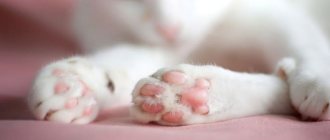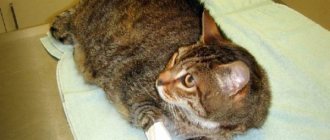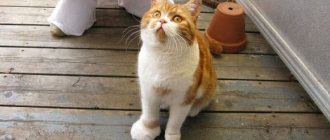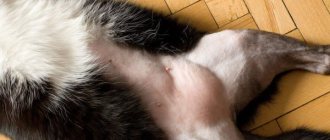- home
- Symptoms
- Paw failure in dogs and cats
The phrase “paws fail” usually refers to two main syndromes of impaired support ability of an animal. Paresis is a decrease in muscle contractility of one or more limbs. Paralysis is the complete absence of motor activity in one or more limbs. Also, often by this “symptom” owners mean other pathologies associated with the lack of motor activity of the animal.
Let's try to analyze those clinical conditions of the animal that owners most often treat, saying “the paws have given up”:
- The cat does not support itself on one or more limbs. Most often these are the pelvic limbs, sometimes only the forelimbs, or all four. In this case, the paws can be either completely relaxed or, conversely, hypertonic.
- The cat leans on all its limbs, but there is a disturbance in motor activity and “drags its paws.”
- The cat is lying down, and when you try to put it on its feet, it loses coordination in space and falls.
- The cat is lying down, and when you try to stand it, it immediately falls or lies down.
Why does a cat limp on his front leg: injury
As already mentioned, it is for this reason that a cat begins to limp on its paw most often. If the owners notice that it is difficult for their pet to step on its front paw, they should simply remember if anything has happened recently that could cause the injury. A cat may limp, for example, after an unsuccessful jump. Also, an animal’s paw may begin to hurt after someone steps on it, pinches it in a door, etc. In addition, quite often a similar problem is observed in those cats that are allowed to walk outside. A pet can get injured from other animals, after an unsuccessful jump, etc.
Lameness due to injury can range from mild to severe. In any case, if such a problem is discovered, your pet should be examined first. If the lameness is caused by an injury, a wound or swelling will likely be found on the paw. In this case, the animal owner should just wait a day. Most likely, the cat's injury, if he can still step on his paw, will go away after this time.
If the cat does not stop limping after 24 hours, you should take him to the veterinarian. The doctor will examine the animal, make the correct diagnosis and prescribe treatment.
The reasons why the cat began to limp on its front leg could be:
- cuts and punctures;
- fractures and dislocations;
- splinters.
Also, a cat, for example, can break a claw if it jumps unsuccessfully. In this case, the animal will subsequently experience quite severe pain for a long time and, accordingly, will begin to limp.
How to protect your cat from paw problems
First of all, you need to take care of quality nutrition for your pet. Diet plays an important role in the life of any living creature; food should be enriched with vitamin and mineral complexes, fiber, and also building material that helps maintain bones and muscles and strengthen cartilage tissue. Another important point is monitoring the temperature in the room. Older cats and kittens react sharply to cold; it can easily damage their paws. This results in many different ailments that cause severe pain to pets.
Although all medications for animals can be easily found at a veterinarian or pet pharmacy, only a professional veterinarian can prescribe the required dose and number of doses. It is not recommended to self-medicate your pet so as not to worsen its condition.
Otherwise, almost all paw diseases can be treated simply and quickly. Take care of your pet and its health!
Arthritis and arthrosis
This problem usually occurs in fairly old animals. In this case, lameness, of course, does not appear suddenly. At first, it becomes only slightly difficult for the pet to step on its foot. Then the problem gets worse.
If a cat has arthritis and is limping on its front leg, what should you do in this case? If there is such a problem, your pet will need to be shown to a specialist. Unfortunately, it is almost impossible to cure arthritis or arthrosis in old animals. The doctor will most likely prescribe only maintenance therapy.
Pregnancy and postpartum period
Quite often you can find fat tail in pregnant cats, especially if the fetuses in the uterus are large or there are many of them.
Multiple births are hereditary, highly valued and supported in the breeding of elite cat breeds, so in breeding females, a saggy belly pouch is a desirable feature.
Large fetuses are undesirable for breeding, as this means that the mother cat will have a difficult and protracted labor, and a caesarean section may be required. And then the skin fold may change due to sutures.
The fat tail is even more pronounced in the postpartum period in cats, when stretched skin hangs on the abdomen, which within a few days restores its elasticity and tightens.
Elbow dysplasia
This disease occurs in both young and old cats. Unfortunately, purebred animals are especially susceptible to it. Cattery owners often use this method of breeding expensive cats as inbreeding. In this case, kittens are born with pronounced breed characteristics. However, inbreeding significantly increases the risk of offspring developing hereditary diseases. One of these ailments is elbow dysplasia.
Signs of this disease can appear in a pet at a very early age. However, lameness in a cat with this problem becomes most noticeable at 2-3 years of age. Of course, such animals should not be allowed to breed. Also, the cat should definitely be taken to the veterinarian.
Like arthrosis, it is unlikely that it will be possible to cure dysplasia in a pet. However, the doctor will still choose a treatment regimen that will make the cat’s life more comfortable. The main symptoms of this disease in cats, in addition to lameness, are:
- crunching sounds when moving;
- X-shaped curvature of the limbs;
- stiffness of movement when standing up.
How to help your pet?
If any, even subtle, changes appear in the cat’s gait, or if she begins to miss when jumping, walk “like a drunk,” and especially fall to the side, she needs to be taken to the veterinarian. Gait disturbances and falls are most often a sign of a serious illness, and delay can be fraught with death for the pet.
You should not wait until the animal’s gait returns to normal or amuse yourself by looking at your pet’s clumsy attempts to move.
It is not the cat’s fall itself that requires treatment, but the cause that causes it.
If there is a lack of thiamine, it is necessary to harmonize the animal’s diet; in case of cerebral edema, diuretics are prescribed. If there is blood loss, the animal may need a blood transfusion, and if there is internal bleeding, surgery may be necessary to eliminate the cause of the bleeding.
There is no treatment for hereditary diseases leading to coordination disorders. For brain tumors, surgery or chemotherapy may be recommended. For malignant neoplasms, the prognosis is unfavorable.
Infectious diseases require specific treatment. For bacterial pathology, antibiotics are used. For a viral infection, complex treatment is required. Any disease requires proper treatment. In most cases, it is impossible to help a cat on your own.
Osteomyelitis in cats
If a domestic cat is limping on its front leg, this may also indicate that it has developed this dangerous disease. The disease in this case also manifests itself gradually. Osteomyelitis is a disease associated with bone necrosis, accompanied by a purulent-inflammatory process.
Most often, this unpleasant disease occurs in cats under the age of 2 years. At the same time, pets of the Persian breed are considered the most susceptible to it. Veterinarians explain this by hereditary predisposition. Osteomyelitis is usually treated comprehensively - through surgery, as well as medications.
There are paralysis (immobility) and paresis (weakening) of the limbs. Paralysis may occur suddenly, or may develop as a result of paresis. Paresis, in turn, can also occur suddenly, or it may be preceded by some symptoms.
Signs that the paws are failing: - wobbling of the hind limbs, unsteadiness in gait. - dragging, dragging paws. The cat moves its hind legs without lifting them from the floor. - frequent squats, the cat’s hind limbs move apart.
If these signs are observed in small kittens that are still learning to walk, then this, of course, is not a sign of a disease. These are natural causes and do not require treatment.
Most often in clinical practice, we observe sudden failure of the hind legs in cats, without any warning signs. A cat crawling on its front legs with its hind limbs dragging behind it greatly frightens its owners. In fact, this condition really indicates a serious problem. Sometimes insoluble. It is also good if the cat does not stand on its paws, but feels them and experiences pain when its toes are irritated. It’s really bad when a cat doesn’t stand on its paws and doesn’t feel them at all.
The main causes of hind leg failure in cats: 1. Mechanical traumatic injuries to the spine. 2. Thromboembolism of the arteries of the extremities. 3. Acute neurological disorders of the brain. 4. Tumor diseases. 5. Inflammation of the spinal cord or brain. 6. Acute poisoning.
As we see, there are several reasons for hind limb failure in cats, but all of them are quite serious. Let's look at each point in more detail.
1. Spinal injuries. In cats, with a fracture, dislocation of the spine, or severe contusion of the spinal cord, a post-traumatic reaction often occurs - the hind legs are taken away. Paw paralysis may be accompanied by painful shock, loss of consciousness, and fecal and urinary incontinence. Damage to the spinal cord can occur as a result of an animal falling from a height, biting, or a strong blow. Moreover, the closer the injury is to the head, the more severe the consequences. Thus, damage to the cervical region can lead to paralysis of the entire torso and limbs, and damage to the pelvis can only lead to paralysis of the tail. Most often the spine is damaged in the thoracolumbar region. With such an injury, paralysis of the hind limbs occurs, and the front legs and head fully retain their functions. The diagnosis is made based on the clinical picture and radiographic examination. With closed injuries, the spinal cord can be compressed by edema or hematoma - in this case, with proper treatment and the absence of complications, the animal’s condition is usually reversible and after restoration of nerve conduction, paw sensitivity and motor functions gradually return. The scope and appropriateness of treatment measures are prescribed by a veterinarian. In different situations, both conservative and surgical assistance are possible. There are situations when any conceivable measure has an unfavorable prognosis. This happens, for example, with spinal cord ruptures, irreversible damage, myelomalacia or necrosis.
2. Arterial thromboembolism (ischemic neuromyopathy). This is a very dangerous condition that occurs when the femoral artery is blocked by a blood clot. In such a situation, the cat experiences severe pain in the lumbar region and is unable to rise on its hind legs. Symptoms develop very acutely: the animal screams in pain, is agitated, drags its paws behind it, there is no femoral pulse, the paw pads turn blue and cold, and there is often a rapid heartbeat and open-mouth breathing. There are several reasons for the development of this pathology. Most often, this is a consequence of a heart disease called hypertrophic cardiomyopathy (HCCM). This heart pathology leading to heart failure is especially common in cat breeds such as Maine Coon, Ragdoll, Sphynx, British and Scottish Fold. But embolism can also occur for the following reasons: in septic and shock conditions; as a result of injuries and bleeding; after major surgical interventions; with tumor processes in the abdominal cavity; as a result of transfusion of incompatible blood; for acute poisoning; and develop for iatrogenic reasons. I would like to especially highlight the last point - iatrogenic pathology. This is the development of thromboembolism with inadequate use of drugs that increase blood clotting, leading to hypercoagulation. For example, they treated cystitis, there was blood in the urine, and they took Vicasol, Dicinone, aminocaproic acid, rutin for a long time, and, as a complication, they received thromboembolism. Such drugs should be taken under the supervision of a doctor! The prognosis for thromboembolism is cautious towards unfavorable. Treatment, including surgery, must begin immediately. Initially, vasodilators, hormones, and antioxidants are prescribed. In parallel, an infusion of high molecular weight solutions is carried out. Fibrinolytics, thrombolytics and anticoagulants are immediately administered. If conservative treatment does not produce results within 8 hours, then surgery is indicated. It also does not always give a positive result, but it is the only way out. Due to the severity of the pathology, death after blockage of the artery can occur within 12-18 hours. Therefore, if drug therapy does not produce quick positive results, then there is nothing to lose.
3. Acute disorders of cerebral blood supply. Stroke. These are conditions in which the brain. or its area, does not receive enough blood, which causes a sharp deterioration and disruption of its functioning. The main symptoms of acute disturbance of cerebral blood supply: unnatural position of the head; impaired balance and coordination; deterioration of vision up to blindness; involuntary urination and defecation; uncontrolled movement of the pupils and eyeballs; refusal to eat; fainting; convulsions; partial paralysis; memory loss and "eccentricity". It is believed that the causes of strokes and cerebrovascular accidents in cats are completely different from those in humans. If in humans the main cause of strokes is a rupture or blockage of a vessel in the head, then in cats the main causes are as follows: head injuries; poisoning with strong toxins, including rat poison; prolonged fever; severe stress. Due to the fact that the brain of animals has a small mass and does not have clearly defined functional zones, a stroke is more easily tolerated in them. However, with serious brain damage, rapid death is possible. But if death does not occur within 24 hours after the onset of initial symptoms and the animal’s condition does not worsen, then there is every chance of improving the situation. Treatment of the pathology is complex. The primary treatment plan involves eliminating the causes that caused the disruption of cerebral blood supply. At the same time, anti-inflammatory and decongestant drugs, antibiotics, antihypoxants, sedatives, anticonvulsants and antiemetic drugs are used. All drugs are carefully and over a long period of time introduced into the dropper. During treatment, the patient must be under the supervision of doctors. Typically, stabilization of the patient takes 1-2 days. In situations of exacerbation of the situation, a transition to intensive care is possible - an oxygen chamber, controlled hypotension and coma. The prognosis for brain disorders is always cautious, especially in older animals. According to statistics, acute disorders of cerebral blood supply and stroke are not a common cause of limb failure in cats.
4. Tumors. The variety of tumor diseases that can cause limb failure is quite large. For example, these could be spinal tumors that can compress the spinal cord and cause neurological deficits. These can be giant abdominal tumors that can disrupt the blood supply to the trunk and limbs and cause thromboembolism or stroke. These could be tumors of the brain or spinal cord that can compress or destroy areas of contact healthy nerve tissue, thereby disrupting the conductivity of the latter. In the end, these may also be oncological problems not directly related to the blood vessels and brain, for example, disseminated lung cancer or osteosarcoma of the bones. Malignant widespread tumor processes in the body lead to its general poisoning. And chronic increasing intoxication can lead to the same symptom complex - impaired cerebral blood supply, thromboembolism, etc., and as a result - limb failure. Due to the diversity of tumor diseases and the versatility of the consequences caused by them, each case of limb failure due to oncological processes is individual. Prognosis, the possibility of treatment, consequences - all this is decided by the attending physician. In difficult cases, the decision is made collegiately - by a group of doctors. The percentage of limb failure due to tumor diseases is small. But we should not forget that oncology itself consistently ranks second among the causes of overall mortality in domestic animals. Moreover, there are many orthopedic diseases that are caused by cancer. They begin with slight pain or lameness on the paw, but if not diagnosed in a timely manner, they can quickly lead to death. Only a periodic preventive examination by a veterinarian will help to timely diagnose and treat such a terrible disease of our time as oncology.
5. Inflammation of the brain or spinal cord. Myelitis can occur as a result of blood poisoning, helminthic infestations, poisoning with heavy metal salts, as a result of aggressive drug effects on the body, trauma or autoimmune reactions. Inflammation of the spinal cord is also possible as a complication after epidural anesthesia or myelography. Treatment in these situations is aimed at eliminating the factor or factors that caused the inflammation. In cases of septic tissue damage to the brain or spinal cord, when the nerve tissue is inflamed due to microbial invasion, treatment is carried out with a group of special antibiotics. The fact is that not all antimicrobial drugs are able to penetrate the blood-brain barrier, that is, penetrate the brain. An incorrectly selected antibiotic will not have an effect on the microbe that destroys the brain. Therefore, it is very important before starting treatment for myelitis to decide on its type - aseptic or septic. That is, microbial or germ-free. Correctly and timely treatment usually has a positive result. The only exceptions may be elderly animals. In them, as a rule, due to age-related changes in the body, recovery may not be complete.
6. Poisoning. Acute or chronic intoxication can cause all of the above-mentioned causes leading to limb failure: thromboembolism, acute cerebral disorders, stroke, inflammation of the meninges. Acute poisoning with timely assistance usually gives a positive result. Treatment is aimed at evacuating poison from the body, preventing its penetration into the body and removing poison that has already entered the body. The treatment protocol for each case of poisoning is individual, but usually includes intravenous drips, forced diuresis, and the administration of antidotes and symptomatic agents. It is important to remember about the timeliness of assistance. After all, the poison is so strong that it could partially paralyze the nervous system. Chronic poisoning is much more insidious. After all, nervous tissue has been attacked by neurogenic poisons for a long time, which led to a partial loss of its functions and paralysis. As a rule, chronic poisoning is small but constant amounts of poison entering the body. For example, this happens with tumor diseases, with the constant administration of potent drugs, with improper feeding. The prognosis in such cases is cautious and often unfavorable. Treatment is often not effective enough.
IMPORTANT: — Herniated discs in cats almost never cause paralysis of the limbs. If in dogs discopathy, hernias and extrusions of spinal discs are the main cause of paw failure, then in cats the same diseases do not cause similar symptoms. Intervertebral hernias in cats usually manifest only as increased pain in the spinal column, gait disturbance and meteopathic syndrome. Paralysis of the hind legs in cats can only occur with obvious spinal injury: displacement, rupture, closed hematoma, etc. — Renal colic and urolithiasis cannot cause limb failure. These diseases can only cause severe pain, but not paralysis of the paws. — Stormy heat in cats with dragging hind legs does NOT lead to paralysis. This only indicates a very high desire to mate. If a cat is constantly “empty,” that is, her estrus does not end with pregnancy, this, of course, also undermines her health, it is recommended to sterilize such animals.
Doctor of Veterinary Medicine M. Shelyakov
Lameness due to infection
If the cat begins to limp on its front leg, it may have become infected with calcivirus. This disease of an infectious nature is very easily transmitted from a sick animal to a healthy one. For prevention, many cat owners vaccinate them against this disease. Animals that have not been vaccinated can become ill with calcivirus very easily.
In addition to lameness, signs of this disease may include:
- breathing problems;
- conjunctivitis;
- nasal discharge;
- damage to the paw joints;
- the presence of ulcers on the mucous membranes.
This disease causes inflammation of the anterior joint chambers. This is why the cat is limping on his front leg. What should owners do in this case? If you have calcivirosis, the animal should, of course, be shown to a specialist. Treatment in this case is complex - therapeutic and symptomatic.
Another infection that can cause lameness in a cat is a fungus. In this case, dermatophytes often affect not only the animal’s pads or its skin, but also its claws or joints. Lameness in cats in this case develops due to inflammation.
Breed characteristics
Some cat breeds are characterized by the obligatory presence of a fat tail (a genetically determined trait), these include:
| Cat breed | Phenotype feature |
| Hairless cats | No fur |
| Sphinx (Canadian, Egyptian) | Straight ears |
| Bambino | Shortened paws |
| Elf | Ears turned back |
| Ukrainian Levkoy | The tips of the ears are rounded inward |
| Cohona | Round ears, many folds |
| Peterbald | Large long ears, narrow muzzle (like Orientals) |
| Britons or British Shorthair cats ("blue blood") | Flat muzzle, voluminous cheeks, predominantly yellow eyes, short harsh coat, plush appearance, deep gray color |
| Scottish cats: Scottish Fold (low-eared) and Scottish Straight (straight-eared) | Flat muzzle, soft short fur of various colors, predominantly yellow eyes, ears may be straight, partially flattened or lying on the head |
| Savannah | Large spotted cat, hybrid with wild breeds |
| Chausie (housey) | Large (up to 15 kg) wild-colored cats with thick, dense, short hair |
| Cornish Rex | Short wavy coat |
| Bengal cat | Complexly colored spotted fur (leopard-like) |
| Kanaani | Tassels on large ears, spotted color |
The breeds listed above also have some characteristics. For example, the Scots: not all representatives have a hanging belly, but only the European line (and this feature is clearly noticeable in small kittens).
Bambino cats
Elf cat
Peterbald cat
British cat
Scottish cat
Chausie cat
Bengal cat
Among the Canadian Sphynxes, the appearance of a pronounced belly after castration of cats is considered the norm, which adds some charm to them and touches the owners.
Important! Hairless breed cats require special care for skin folds throughout the body (wipe with wet wipes) due to the increased oiliness of the skin.
All British cats have a hanging belly from an early age and this should not frighten new owners. A fold of fat between the hind legs is not a flaw in the appearance of show animals; experts do not pay attention to it at shows. Even in British cats of thin build, the fat tail stands out clearly.
Pretense
Sometimes it happens that the animal has no visible injuries, but the cat still limps on its front leg. The reason in this case may simply be the nature of the animal. A pet whose paw is slightly pinched or, for example, stepped on, may be offended. In this case, the cat, even if it does not feel any discomfort in its paw, begins to limping demonstratively only in order to express its indignation to its owners.
If the lameness is simply emotional, there will most likely be no damage to the animal's paw. Moreover, after a couple of hours the cat will get tired of playing, and he will stop limping.
Symptoms and diagnosis of dislocated paws in cats
There are several types of dislocations. Depending on the species, the symptoms of the pathology differ. Dislocation can occur in any joint, but most often occurs in the joints of the limbs. The forelimbs are most often affected. As a result of complete dislocation of the articular surfaces, mobility is impaired.
Incomplete dislocation is accompanied by partial contact of the articular surfaces. The animal cannot fully move its paw, swelling develops, and any attempts to make a movement provoke severe pain.
Among the symptoms of a forelimb joint dislocation, a characteristic sound is noted - a clicking or grinding sound. Dislocation can occur in the shoulder area. Correcting such a violation is quite easy for a qualified veterinarian.
Dislocation of the kneecap is accompanied by the dislocation of the patella from the condyles with parallel displacement of the ligaments. An incomplete dislocation of the kneecap can straighten itself, causing a minimum of discomfort.
When the hip joint is dislocated, which occurs more often with injuries of a mechanical nature, the head of the tibia comes out of its physiological place - a special cavity. Dislocation of the hip joint can occur not only with serious injuries. There is a high probability of this type of dislocation in cases of dysplasia, bursitis, osteoporosis and inflammation of the joints in animals. The pathology is characterized by damage to the joint capsule, which leads to an increase in the load on the ligaments that support bone and muscle structures. Often there is a tear in the ligaments or muscle fibers.
This leads to the appearance of characteristic symptoms. The cat places the pelvic limb at a special angle, mobility is very limited. The pet suffers from pain even in those moments when it does not rely on a limb. A characteristic swelling occurs.
To make an accurate diagnosis, a detailed examination is necessary. It can only be carried out in a veterinary clinic by a qualified doctor.
The specialist conducts a full examination of the pet, identifying the characteristic signs accompanying the damage.
The affected part is palpated, which makes it possible to determine the exact location of the damage. An important part of the diagnosis is radiography. If a complicated injury is suspected, for example, if the animal was hit by a car, the veterinarian recommends magnetic resonance imaging.
During the examination, the animal experiences pain and may show anxiety or aggression. To calmly carry out a thorough diagnosis, the dog is given an anesthetic injection or put into a state of deep sleep.
In what cases should a cat be taken to the veterinarian?
When is specialist help needed? When the animal exhibits at least one of the following symptoms:
- the cat cannot walk at all or moves with great difficulty;
- when you touch the paw, the pet meows and abruptly pulls it away;
- the cat does not step on its paw, tucking it in when moving.
It is also worth visiting a specialist if the cat’s lameness is accompanied by loss of appetite, high fever, increased fatigue, lethargy or aggression. These are already very alarming symptoms.
Causes of pathology
The main reason for the development of pathology is heredity. Moreover, in the vast majority of cases, dysplasia is diagnosed in purebred cats. Scientists have found that a defective gene can be passed on to offspring even if both parents were completely healthy. It is also noteworthy that the genetic deviation can be traced even after 15 generations.
However, it cannot be said that the development of dysplasia is influenced only by a hereditary factor - a combination of characteristics is responsible for this.
Let's look at the most common causes of dysplasia in cats.:
- too early sterilization or castration, as a result of which longer growth of bone tissue was provoked;
- excess weight is the cause of increased load on the joints and the development of their deformation;
- injuries to the spine or limbs;
- low physical activity;
- increased cat growth;
- calcium deficiency in the body, rickets;
- hormonal imbalances;
- congenital pathologies in the structure of the chest and joints;
- eating only meat or dry food.
© shutterstock
Despite the fact that scientists have concluded that joint dysplasia in cats depends on heredity, the gene responsible for the pathology has not yet been identified. It is believed that malalignment of joints does not depend on one gene, but on a specific set of several genes that affects the deformation of the cat's musculoskeletal system.
The cat is limping on his front leg. What to do in this case, how to provide first aid to your pet?
As already mentioned, a limping animal should be left alone for one day and then taken to a veterinarian. Also, if a bruise is revealed during examination, you can apply cold to the affected area for 1 minute, wait 20 seconds and apply again for 1 minute. This operation should be repeated for 5 minutes.
If the owners suspect that the cat has a fracture, he needs to try to fix the paw. In this case, the animal must be taken to the clinic in an immobilized state. You can also try to provide first aid to a cat if he has a minor wound. In this case, the affected area must be carefully cleaned from dirt with a cloth soaked in soapy water. After this, the wound should be treated with furatsilin solution and the animal should be taken to the veterinarian.











